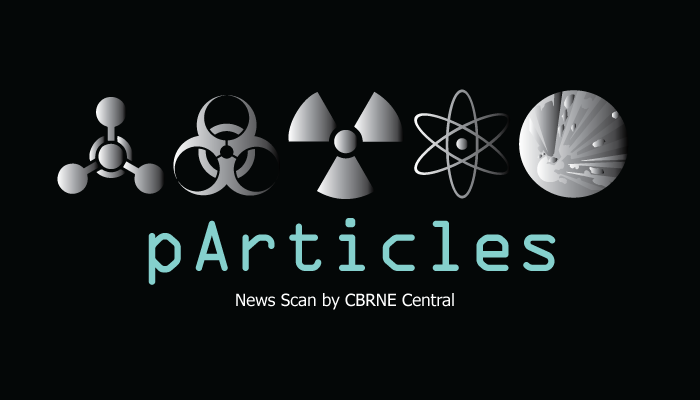Topics in this issue of CBRNE Particles include measuring radiation dose exposure in mass casualty emergencies, Counter-IED jamming systems, and streamlining pandemic vaccine development.
In This Article
RADIOLOGICAL + NUCLEAR
EPA Publishes Two Essential Communication Resources for Radiation Emergencies
To further assist during radiological incidents, EPA has recently published two companion documents in conjunction with the Protective Action Guide (PAG) Manual. While the PAG Manual contains radiation dose guidelines that initiate public health safety measures, these new EPA companion documents support quick and clear communications to the effected public. Homeland Security Digital Library >>
Metro Transit Police to Receive Radiation Detectors in Face of ‘Dirty Bomb’ Threat
The Metropolitan Washington Council of Governments used $2.4 million in federal grant funding to buy 375 personal radiation detectors for transit police officers, plus more than 80 specialized devices for use by special teams or in special circumstances. Those specialized devices include 10 portable systems that can be used at security checkpoints and 11 devices that identify the type of isotope emitting the detected radiation. WTOP >>
Opinion: Implement the JCPOA
The JCPOA ultimately rests upon the authority of the International Atomic Energy Agency (IAEA) to verify that all of Iran’s nuclear activities are declared and peaceful. Without the agreement, IAEA verification would be far more difficult. This should dissuade President Trump and the Congress from taking reckless actions that could curtail the IAEA’s fact-finding, preempt American credibility in dealing with Iran in the future, and terminate enhanced oversight in a country that could respond by ramping up its nuclear program to a crisis level. Arms Control Wonk >>
Measuring Radiation Doses in Mass-Casualty Emergencies
The medical consequences of even a single nuclear detonation would be horrific. According to Jerome Hauer, former director of emergency management for New York City, no city in the United States is prepared for the casualties, chaos, and destruction that would follow a nuclear detonation. Medical management in particular would be complicated by damage to infrastructure and communication systems, lack of sufficient first responders, scarce resources, complicated triage needs, and an overwhelming number of patients. Bulletin of the Atomic Scientists >>
How the U.S. And China are Working Together to Get Weapons-Grade Uranium Out of Ghana
An airlift 10 years in the making occurred in August, when a highly enriched uranium reactor was flown out of Ghana and replaced with a more efficient core, the product of the first cooperation between U.S. and Chinese nuclear researchers in 20 years. Science’s Richard Stone was on the ground in Ghana, and talks about his experiences traveling the world and reporting on these international efforts to improve nuclear security. Science >>
EOD, C-IED + COUNTERMINE
Air Force, Navy Team Up to Acquire New Counter Radio-Controlled Explosive Technology
The Air Force and Navy have teamed up to a acquire new electronic warfare jamming device to identify and block IED attacks, service officials said. As a response to new and increased Radio-Controlled Improvised Explosive Devices RCIED threats, the Air Force and the Navy will both be trading in their current Controlled Improvised Explosive Device Electronic Warfare (CREW) systems for the new Joint Counter Radio-Controlled Improvised Explosive Device Electronic Warfare Increment One Built One (JCREW I1B1) systems. Defense Systems >>
S&T and the Pentagon are Changing K-9 Bomb Detection
The Department of Homeland Security (DHS) Science and Technology Directorate (S&T) Detection Canine Program partnered with the Pentagon Force Protection Agency (PFPA) to assist in developing a training initiative to add person-borne improvised explosive device (PBIED) detection capabilities to their canine teams. Traditionally, dogs sniff out “left-behind” bombs, but Sunny and the other members of his K-9 unit are also trained to pick up explosive scents on a person or any moving target. Department of Homeland Security >>
Pak-US to Make Combined Effort Against IEDs
Pakistan and the United States have agreed to make combined efforts to combat the Improvised Explosive Device threat, reported Radio Pakistan. The agreement came during the visit of Director of the US Department of Defence’s Joint Improvised-Threat Defeat Organization Lieutenant General Michael Shields to Pakistan. The Nation >>
BIOLOGICAL DEFENSE
Plague is Spreading at an Alarming Rate in Madagascar. Yes, Plague.
People in Madagascar are scrambling to get their hands on antibiotics and face masks, while public gatherings have been canceled, as a rare pneumonic plague epidemic spreads quickly across the country. As of October 6, 231 plague cases there had been identified, as well as 33 deaths, according to the World Health Organization. Twenty of Madagascar’s 114 districts are now affected by the epidemic. Vox >>
Preparing for Pandemics and Streamlining Vaccine Development
Taking a cue from the World Health Organization’s blueprint for action, a handful of diseases were identified as requiring urgent action in terms of preparedness. The action can utilize a number of platforms, including nanoparticles, microbial vectors, DNA-based technologies, and others. The DNA-based approach has sped up vaccine development. In the recent Zika virus outbreak, the timing from virus discovery to vaccine development was less than 4 months. Contagion Live >>
RESPONDER + MILITARY HEALTH
Chemical Weapons Tied to Long-Term Cognitive Issues in Gulf War Vets
A new study finds that Gulf War veterans who had low-level exposure to chemical weapons are likely to experience long-term negative effects on brain structure and memory function. In previous research, Linda Chao, Ph.D., and colleagues of San Francisco VA Medical Center reported decreased volume of the hippocampus — a brain area involved in memory processing — in Gulf War veterans who had been exposed to the Khamisiyah plume. Psych Central >>
Working in Harm’s Way: Mitigating Occupational Violence to Firefighters and EMS Responders
A new report indicates that while violence against EMS responders has been recognized as an occupational hazard since the early 1970s, and increased attention has been paid to the problem over the years, there has been little cohesion with regard to how to predict risk factors and how to minimize the impact of such violence on EMS responders. Homeland Security Digital Library >>
CHEMICAL WEAPONS
Chemist Says Kim Had 1.4 Times Lethal Dosage of VX on Face
The estranged half brother of North Korea’s leader had about 1.4 times the lethal dosage of VX nerve agent on his face after he was attacked at a Malaysian airport, a government chemist testified Tuesday.
VX was found on Kim Jong Nam’s face, in his eye and in his blood plasma, Raja Subramaniam, who heads the Center of Chemical Weapons Analysis laboratory, said at the murder trial of two women accused of smearing the chemical weapon on Kim in the brazen assassination in February. Associated Press >>
Synthesis of a Zr-Based MOF with Spirof-MOF for the Effective Removal of Nerve Agent Simulants
A new microporous Zr(IV)-based metal–organic framework (MOF) containing Spirof-MOF was synthesized, characterized, and size-controlled for the adsorption and decomposition of a nerve agent simulant. Spirof-MOF showed a hydrolysis half-life 7.5 min to DMNP, confirmed by in situ 31P NMR spectroscopy. Inorganic Chemistry >>
Search Continues for Chemical Weapons in Lincolnshire
Police and other agencies are continuing to search Roughton Moor Woods, near Woodhall Spa, Lincolnshire. Sonar is being used to help search a nearby lake. Two people were treated in hospital for minor burns after making the find. A woman and two men have been arrested and bailed on suspicion of possessing a noxious substance. BBC >>
OPCW Marks Completion of Destruction of Russian Chemical Weapons Stockpile
The OPCW’s inspection teams have verified the destruction at seven chemical weapons destruction facilities in the Russian Federation. On 27 September 2017, the last of these facilities, located in Kizner, officially concluded its operations. a ceremony to mark the completion of the destruction of the Russian Federation’s chemical weapons took place today at the residence of Ambassador Alexander Shulgin, the Permanent Representative of the Russian Federation to the OPCW. Organisation for the Prohibition of Chemical Weapons >>
Characterization of DNA Adducts of an Oxidative Metabolite of Sulfur Mustard
Divinyl sulfone (DVS) is an important oxidative metabolic product of sulfur mustard in vitro and in vivo. Although DVS is not a classical blister agent, its high reactivity and toxicity induced by vinyl groups can also cause blisters like sulfur mustard upon contact with the skin, eyes, and respiratory organs. The purpose of this paper was to identify whether DVS could covalently bind to DNA bases to form new DNA adducts in cells in vitro. Chemical Research in Toxicology >>
Latin American and Caribbean Service Members Join Forces in Anti-Chemical Weapons Exercise
From August 28th to September 1st, Rio de Janeiro hosted 15 service members and representatives of chemical emergency response agencies from Brazil, along with 22 representatives from 18 other countries in Latin America and the Caribbean for the Regional Assistance and Protection Exercise for Member States of the Latin American and Caribbean Region (ExBRALC II, per its Portuguese acronym). The exercise closed out a series of regional trainings previously conducted in Uruguay and Argentina with the goal of developing skills to protect society against chemical-product threats. Diálago >>
Chemical Attacks – Addressing the Threat
Q&A Interview with Homeland Defense & Security Information Analysis Center (HDIAC) Chemical, Biological, Radiological, and Nuclear Defense Subject Matter Experts Robert Walk and Stephen Malone to discuss the threat posed by chemical attacks. HDIAC >>
EMERGENCY PREPAREDNESS
Revisiting Preparedness, Management, and Recovery for Mass Casualty Events
Last night’s tragedy in Las Vegas, Nevada has highlighted the enormous potential risks and response difficulties posed by mass gathering events. Planning efforts by event organizers, local officials, and law enforcement set the stage for general safety during an event, but a mass gathering presents unique difficulties when an emergency occurs. Homeland Security Digital Library >>
US Embassy in Baku Holds WMD Detection, Identification and Response Training
The course covered the sizes, shapes and packaging of the various weapons and materials as well as protective measures. WMD-DIRT includes modules on real alarms and response. Practical exercises include response training using low-level radioactive sources and simulated WMD threat materials and items such as simulated vehicle-borne improvised explosive devices. Trend News Agency >>
SPECIAL INTEREST
West Texas After the Blast
Blessings abounded in the Texas town of West, population 2,800, on that April day in 2013 when the fertilizer plant caught fire and its ammonium nitrate detonated — killing 15, injuring 252 and damaging or destroying 500 buildings. Investigators have spent 41/2 years and millions of dollars trying to determine what happened that day in West. The town, though, has already figured it out. NY Times >>
From the Field: Research from Homeland Security Practitioners
Homeland Security professionals taking advantage of advanced continuing education programs often complete final research projects or papers examining current issues and thinking in their field. Many of these programs are targeted to specific professions, such as law enforcement and firefighting, and the papers produced often present innovative and practical solutions to common problems faced by homeland security practitioners in these fields. HSDL >>
Anti-Nuclear Weapons Group ICAN Wins Nobel Peace Prize
The Nobel Peace Prize has been awarded to the International Campaign to Abolish Nuclear Weapons (ICAN). In July, after pressure from ICAN, 122 nations backed a UN treaty designed to ban and eventually eliminate all nuclear weapons. But none of the nine known nuclear powers in the world – including the UK and the US – endorsed it. BBC >>
American Prometheus: J. Robert Oppenheimer
I’ve spent my day off with this wonderful biography of J Robert Oppenheimer. This quotation, on cruelty and responsibility is particularly striking, I think… Perhaps she would not have considered evil to be so rare, so extraordinary, so estranging a state, to which it was so restful to emigrate, had she been able to discern in herself, as in everyone, that indifference to the sufferings one causes, an indifference which, whatever names one may give it, is the terrible and permanent form of cruelty. Dreary Mantle >>
How the U.S. Created a ‘Secret City’ in Oak Ridge to Build the Atomic Bomb, 75 Years Ago
Seventy-five years ago k, the federal government quietly took over 60,000 acres nestled in the ridges of East Tennessee. It was the beginning of Oak Ridge: a city cloaked in secrecy that tens of thousands of people flocked to during World War II, most unknowingly helping to build the world’s first atomic bomb. Nashville Public Radio >>
My Priorities as UN Special Rapporteur on Counter Terrorism: The Problem of Permanent Emergencies
I am particularly concerned at the absorption of normally exceptional national security powers and counter-terrorism measures in the ordinary law of many states. In this context, the dividing line between exercise of exceptional national security powers and the ordinary criminal and civil processes of some states becomes hard to distinguish, and the protection of rights becomes increasingly fraught and difficult to deliver in practice. Just Security >>


